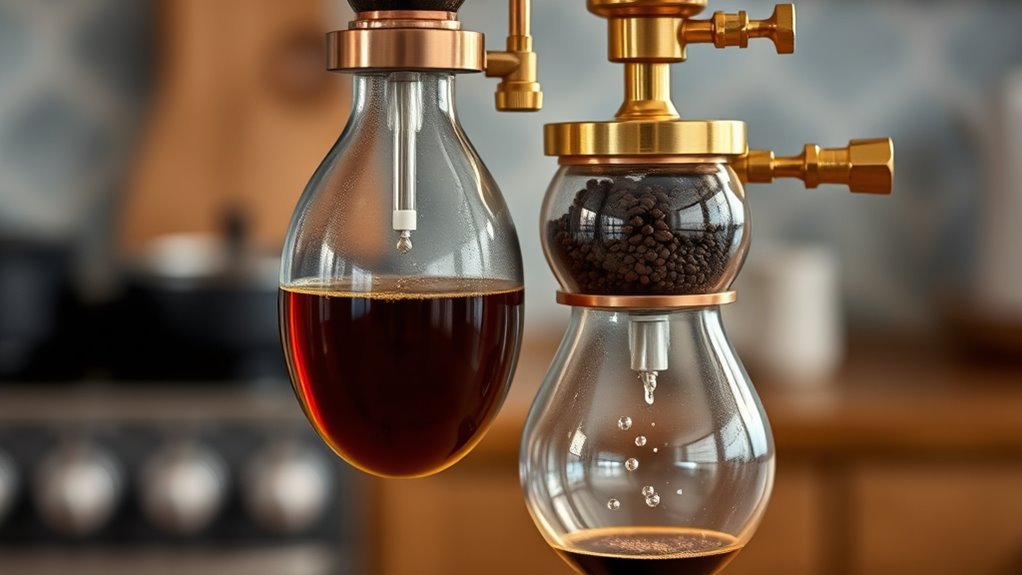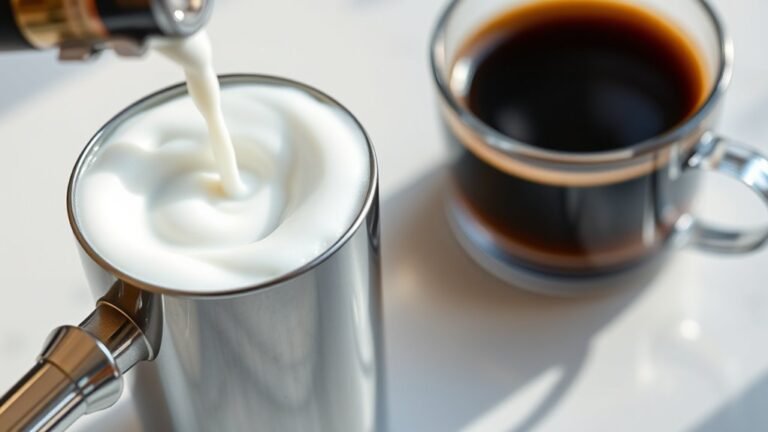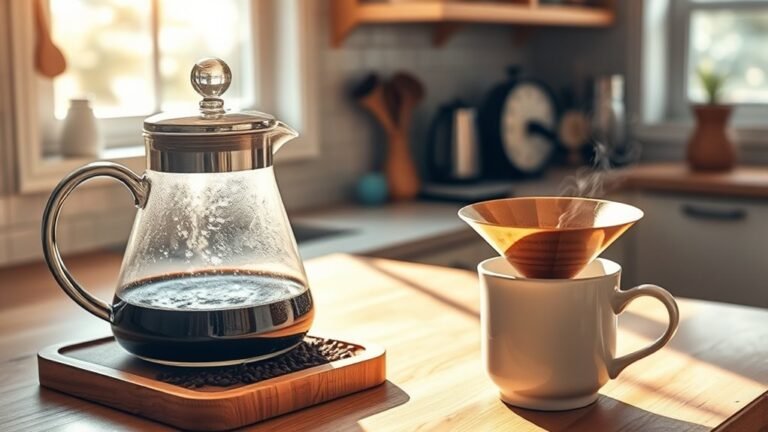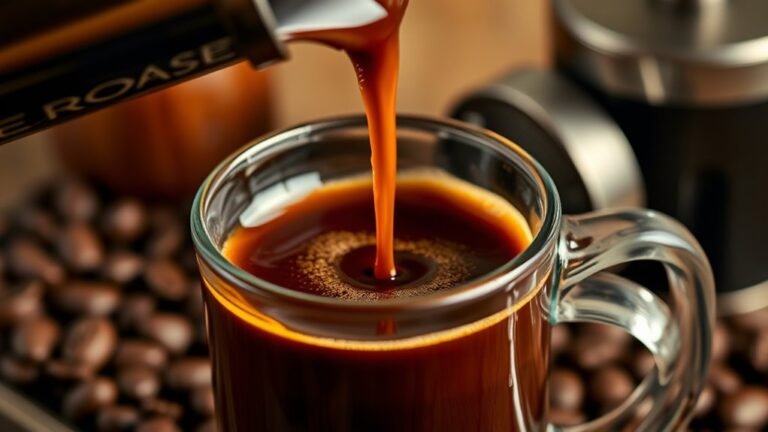Siphon Coffee Makers: A Guide to Vacuum Pot Brewing
Siphon coffee makers use vapor pressure to push hot water through coffee grounds, then create a vacuum that pulls the brewed coffee back down, ensuring clean extraction and aromatic clarity. You’ll need an airtight seal, precise temperature control between 195°F–205°F, and medium-fine grounds for ideal results. This method highlights the clean, complex flavors of single-origin beans, but requires attention to brewing time and careful maintenance. Keep exploring to uncover detailed techniques and common pitfalls to master this elegant brewing style.
History of Siphon Coffee Makers

Although siphon coffee makers may seem like a modern invention, their origins date back to the early 19th century when inventors sought a method to brew coffee using vacuum pressure. You’ll find that the siphon origins trace to Europe, specifically France and Germany, where early designs capitalized on thermodynamics and fluid mechanics. Understanding the historical significance helps you appreciate the precision engineering involved, reflecting advancements in glassblowing and heat control. These devices were not merely novelties but represented a significant leap in brewing technology, enabling a cleaner extraction and fuller flavor profile. By exploring this history, you grasp how the siphon method liberated coffee brewing from conventional drip or immersion techniques, offering a unique balance of control and elegance that still appeals to those who value freedom in their craft.
How Vacuum Pot Brewing Works
Building on the historical advancements in siphon coffee makers, understanding how vacuum pot brewing operates reveals why this method produces such distinct flavors. You start by heating water in the lower chamber, creating vapor pressure that forces water upward through a tube into the upper chamber containing coffee grounds. As water mixes with grounds, precise brewing techniques control extraction time and temperature. Once heating stops, the vacuum created by cooling draws brewed coffee back down through a filter, separating grounds and liquid efficiently. This dynamic pressure-driven process optimizes coffee extraction, preserving nuanced flavor compounds.
| Step | Action | Purpose |
|---|---|---|
| 1 | Heat water in lower chamber | Generate vapor pressure |
| 2 | Water rises to upper chamber | Contact with coffee grounds |
| 3 | Brew coffee under controlled heat | Extract flavors precisely |
| 4 | Remove heat | Create vacuum for filtration |
| 5 | Coffee descends through filter | Separate grounds, guarantee clarity |
Essential Components of a Siphon Coffee Maker
A siphon coffee maker relies on several precisely engineered components working in harmony to achieve its unique brewing process. Understanding the essential parts helps you master advanced brewing techniques and appreciate the quality of siphon materials used. Key components include:
- Upper chamber: Where coffee grounds meet vapor pressure-extracted water.
- Lower chamber: Holds water heated to create vapor pressure.
- Filter: Typically glass fiber, cloth, or metal, vital for separating grounds from brewed coffee.
- Heat source: A burner or alcohol lamp that maintains precise temperature control.
- Siphon tube and seal: Guarantees airtight connection and allows liquid movement driven by pressure differences.
Each element’s quality and design directly impact flavor clarity and extraction efficiency, giving you freedom to explore precise, consistent coffee preparation.
Choosing the Right Coffee Beans for Siphon Brewing
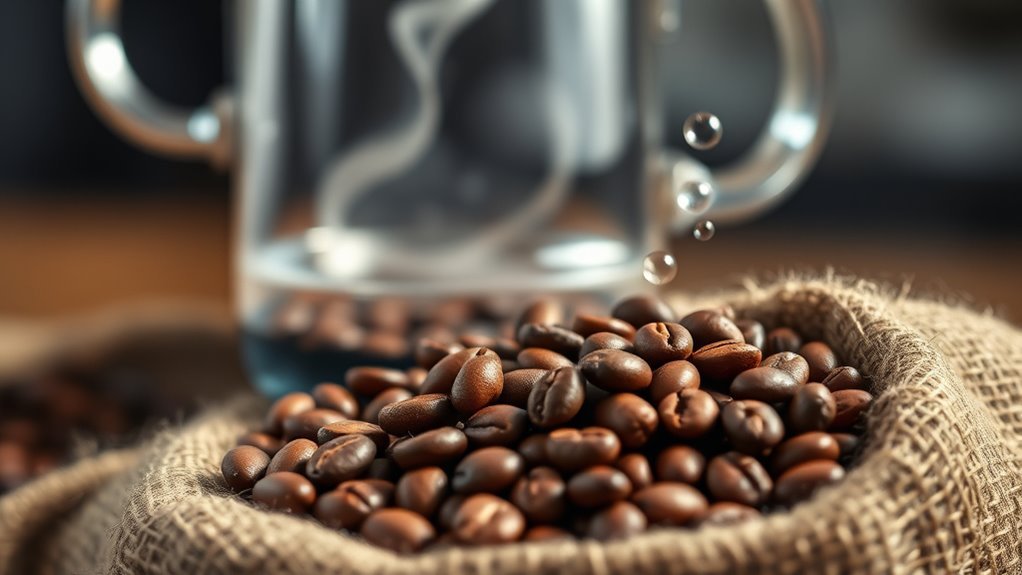
When selecting coffee beans for siphon brewing, you’ll want to prioritize those that highlight clarity and complexity, as the siphon method accentuates subtle flavor notes. Single origin beans are ideal since they preserve distinct regional characteristics, allowing you to experience nuanced profiles clearly. Pay close attention to the roast level: a light to medium roast typically works best, as it maintains acidity and delicate aromatics, which siphon brewing amplifies. Dark roasts can overshadow these subtleties with heavier, smoky flavors. Additionally, verify your beans are freshly roasted and ground just before brewing to maximize extraction efficiency. By selecting beans with precise origin and roast specifications, you gain control over the flavor spectrum, releasing the full potential of your siphon coffee maker.
Step-By-Step Guide to Brewing With a Siphon Coffee Maker
Before you begin brewing, verify all components of your siphon coffee maker are clean and properly assembled to secure ideal extraction. Mastering siphon techniques requires attention to detail throughout your brewing rituals. Start by adding measured water to the lower chamber. Secure the filter in the upper chamber and attach it firmly. Place the siphon on your heat source, gradually heating the water until it rises to the upper chamber. Add your ground coffee and stir gently to saturate evenly. Allow the coffee to brew for a precise duration, then remove the heat, letting brewed coffee siphon back down through the filter.
Ensure a clean, airtight siphon setup and precise timing for a perfectly brewed cup every time.
Key steps include:
- Ensuring airtight seals
- Monitoring water temperature
- Timing the brew precisely
- Stirring gently for even extraction
- Removing heat at the correct moment
This process guarantees a clean, flavorful cup every time.
Tips for Achieving the Perfect Extraction
To achieve the perfect extraction with your siphon coffee maker, you’ll need to precisely control grind size, as too coarse or fine can disrupt balance. Maintaining water temperature within the ideal range guarantees consistent solubility and flavor clarity. Additionally, optimizing brew time is critical to avoid under- or over-extraction, so timing your infusion carefully is essential.
Grind Size Importance
Although grind size might seem like a minor variable, it critically influences the extraction rate and flavor balance in siphon brewing. Achieving grind consistency and grind precision guarantees uniform extraction, preventing over- or under-extraction that can spoil your coffee’s profile. You’ll want to dial in a grind size that balances flow rate and surface area effectively.
Focus on these essentials:
- Use a burr grinder for precise, uniform particle size
- Aim for a medium-fine grind—finer than drip, coarser than espresso
- Avoid inconsistent grind particles that cause uneven extraction
- Adjust grind size incrementally based on taste feedback
- Keep grind size stable to replicate desired flavor notes
Mastering grind size precision releases the full potential of your siphon brewer, freeing you to experiment confidently.
Water Temperature Control
Once you’ve dialed in the ideal grind size, controlling water temperature becomes the next key factor in extracting the best flavors from your siphon coffee maker. Maintaining temperature stability during brewing guarantees that the coffee grounds extract evenly, preventing under- or over-extraction. Aim for a water temperature between 195°F and 205°F (90°C-96°C) just before infusion. Use a precise heat source or adjustable burner to keep fluctuations minimal. Consistent temperature control directly impacts brewing consistency, allowing you to replicate your desired flavor profile every time. Avoid letting the water boil vigorously, as this can cause uneven extraction and degrade delicate aromatics. Mastering temperature stability grants you freedom to explore nuanced taste variations, revealing the siphon’s full potential in producing a clean, balanced cup.
Brew Time Optimization
While controlling water temperature is essential, optimizing your brew time is equally important for extracting the full spectrum of flavors from your siphon coffee maker. Mastering brew time techniques involves adjusting specific brew time variables to balance extraction and avoid under- or over-extraction. To refine your process, consider these key factors:
- Grind size: finer grinds increase extraction speed, requiring shorter brew times
- Coffee-to-water ratio: higher ratios may need longer brew times for full flavor
- Vacuum pressure: influences flow rate and extraction duration
- Heat source consistency: affects the stability of brew time variables
- Stirring frequency: promotes uniform extraction but alters total brew time
Common Mistakes to Avoid When Using a Vacuum Pot
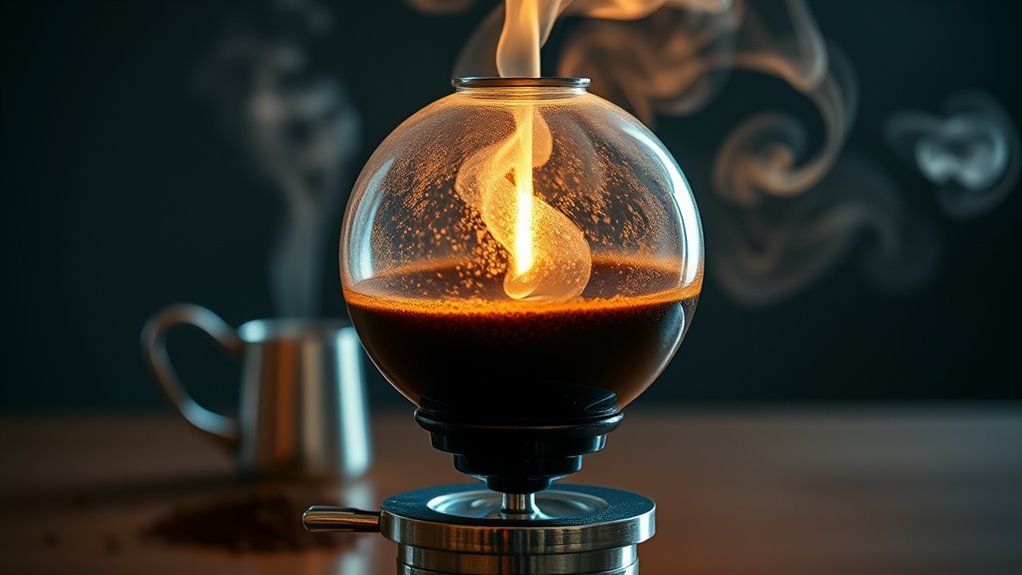
Because vacuum pots rely on precise temperature control and timing, even small errors can greatly affect the extraction quality and flavor profile of your coffee. Common issues include overheating the water, leading to burnt flavors, or underheating, which results in weak extraction. Another frequent mistake is improper grind size; too coarse disrupts pressure balance, too fine clogs the filter. Avoid rushing the vacuum process—patience guarantees ideal flavor. Troubleshooting tips: monitor your heat source carefully, use a consistent medium grind, and verify airtight seals to maintain vacuum pressure. Also, avoid overfilling the lower chamber, as it impedes proper siphoning. Mastering these details grants you freedom to extract complex, balanced coffee flavors, leveraging the siphon’s full potential without compromise.
Cleaning and Maintaining Your Siphon Coffee Maker
Maintaining your siphon coffee maker requires regular and thorough cleaning to preserve peak performance and flavor integrity. Proper siphon upkeep guarantees no residual oils or grounds compromise the vacuum seal or brewing quality. Employ these cleaning techniques to keep your vacuum pot in top shape:
- Disassemble all parts after each use for detailed cleaning.
- Rinse glass components with warm water immediately to prevent staining.
- Use a soft brush to clean the siphon tube and filter, avoiding abrasives.
- Soak rubber gaskets in mild detergent solution to maintain elasticity.
- Perform monthly deep cleans with vinegar or specialized coffee equipment cleaner.
Adhering to these steps assures your siphon coffee maker operates smoothly, freeing you to enjoy flawless, aromatic coffee with every brew.
Comparing Siphon Brewing to Other Coffee Methods
If you want to understand how siphon brewing stacks up against other methods, it’s essential to analyze factors like extraction control, flavor clarity, and brewing mechanics. Siphon advantages include superior brewing precision, allowing you to finely regulate temperature and immersion time, which directly impacts extraction uniformity. Unlike drip or French press methods, the vacuum-driven process minimizes sediment and oils, resulting in a cleaner, more vibrant cup. The closed system also preserves volatile aromatics better than open-air brewers. While espresso excels in intensity and pressure-driven extraction, siphon coffee offers a unique balance of clarity and body. When comparing, consider how siphon’s precise thermal control and vacuum filtration provide a distinct sensory profile, granting you freedom to explore nuanced flavors often lost in other brewing techniques.
Enhancing Your Siphon Coffee Experience With Accessories

To optimize your siphon brewing, consider essential accessories like precision scales and specialized filters that directly impact extraction quality. You can also refine flavor profiles by experimenting with adjustable heat sources and grind size tools. Finally, maintaining your equipment with targeted cleaning brushes and descaling solutions guarantees consistent performance and longevity.
Essential Siphon Accessories
Although the siphon coffee maker itself is a marvel of design, your brewing experience can be greatly elevated with the right accessories. These siphon accessories and brewing tools not only streamline the process but also enhance control and precision. Consider integrating:
- A precision scale for accurate coffee-to-water ratios
- A gooseneck kettle to regulate water flow and temperature
- Extra cloth or metal filters to maintain ideal extraction consistency
- A heat source with adjustable flame for stable brewing temperature
- A stirring paddle designed for gentle agitation without disrupting the vacuum
Enhancing Flavor Profiles
Mastering the right accessories not only simplifies your siphon brewing process but also sharpens your ability to manipulate flavor nuances. Utilizing a precision grinder allows you to control grind size meticulously, directly impacting flavor extraction efficiency. A high-quality thermometer guarantees water temperature stability, essential for peak solubility and preventing bitterness. Incorporating a calibrated scale lets you measure coffee-to-water ratios accurately, enabling consistent strength and clarity in your cup. Additionally, employing a specialized stirrer promotes even saturation of grounds, enhancing aroma enhancement by releasing volatile compounds uniformly. These tools grant you freedom to experiment with variables, refining your siphon coffee’s complexity and balance. By integrating these accessories, you elevate your brewing from routine to artisanal, revealing the full spectrum of flavors inherent in your beans.
Maintenance and Cleaning Tools
A few essential maintenance and cleaning tools are crucial for preserving your siphon coffee maker’s peak performance and longevity. To maintain maximum extraction and avoid residue buildup, adhere to strict maintenance schedules and use specialized accessories. Here’s what you’ll need:
- Soft cleaning brushes designed for narrow tubes and glass chambers
- Microfiber cloths to prevent scratches on delicate surfaces
- Descaling agents safe for glass and metal components
- Precision tweezers for removing lodged coffee grounds
- Airtight storage containers to protect parts from dust and moisture
Incorporating these tools into your routine guarantees consistent vacuum pressure and flavor clarity. Regular cleaning with appropriate brushes prevents clogging, while scheduled descaling maintains heat transfer efficiency. By investing in proper maintenance accessories, you safeguard your brewing freedom and coffee quality over time.
Frequently Asked Questions
Can Siphon Coffee Makers Be Used for Tea or Other Beverages?
You can definitely use siphon brewing for tea or alternative beverages. The precise temperature control and vacuum extraction process make it ideal for delicate leaves or herbs, preserving nuanced flavors. Just adjust steeping times and grind size (or leaf cut) accordingly. This method gives you freedom to experiment beyond coffee, revealing complex profiles in teas, infusions, or even cold brews. Embrace the versatility of your siphon as a multi-beverage apparatus.
Are Siphon Coffee Makers Safe for Children to Use?
You shouldn’t let children use siphon coffee makers unsupervised due to hot liquids and glass components. Safety precautions are essential—make sure they understand how to handle fragile parts and avoid burns from steam or boiling water. Child supervision is critical during the entire brewing process to prevent accidents. If you want kids involved, guide them closely, ensuring they follow precise steps and respect the equipment’s hazards while enjoying the experience safely.
What Is the Environmental Impact of Siphon Coffee Makers?
Think of the environmental impact like a delicate balance beam. You’ll want to take into account sustainability concerns, especially related to energy use during brewing and the sourcing of materials like glass and metal. If these materials come from responsible suppliers, it reduces your carbon footprint. Plus, reusable components cut waste, aligning with your desire for freedom from disposable habits. Overall, careful material sourcing and mindful energy practices guarantee minimal ecological disturbance.
Can I Travel With a Siphon Coffee Maker?
Yes, you can travel with a siphon coffee maker, but you’ll need careful packing techniques to protect its fragile glass components. Use padded cases or bubble wrap to prevent breakage, and disassemble all parts to save space. For travel tips, consider bringing only essential accessories like a small burner and filter. This way, you maintain your freedom to brew quality coffee anywhere while minimizing the risk of damage during transit.
How Much Do Siphon Coffee Makers Typically Cost?
You’ll find siphon coffee makers range widely in price. Budget options typically start around $50 to $100, offering basic materials and manual controls. If you’re seeking precision and durability, high-end models can cost anywhere from $200 to over $500, featuring premium glass, precise temperature control, and enhanced vacuum systems. Choosing depends on how much freedom you want in brewing complexity and how refined you expect your coffee experience to be.
